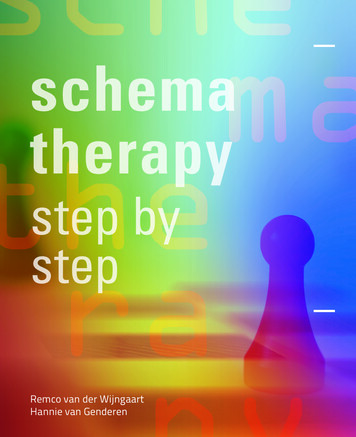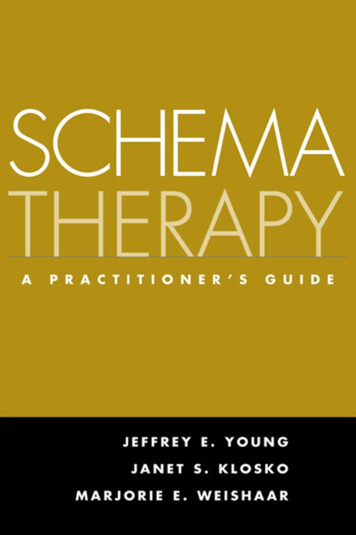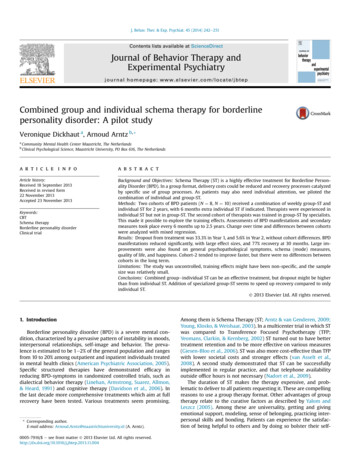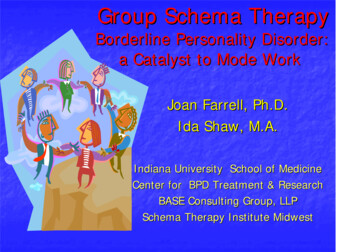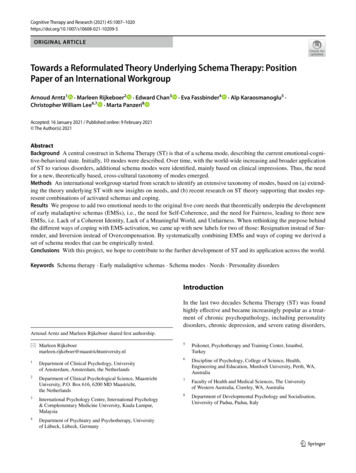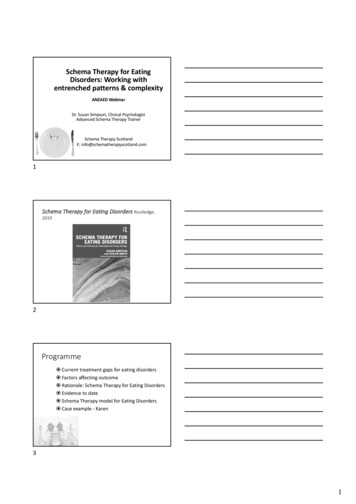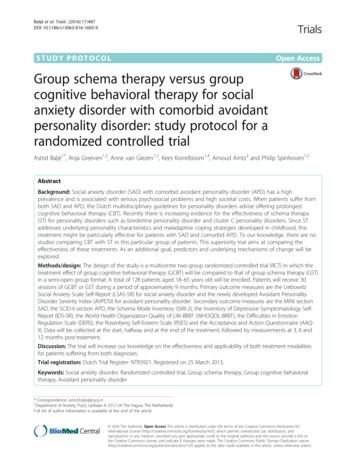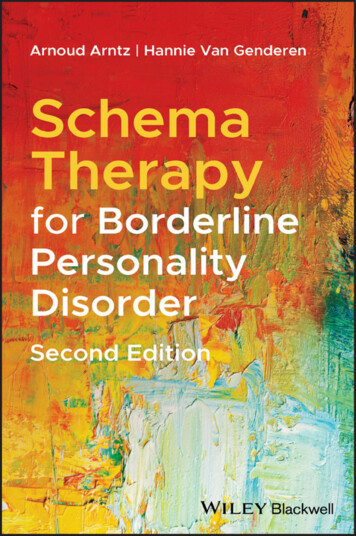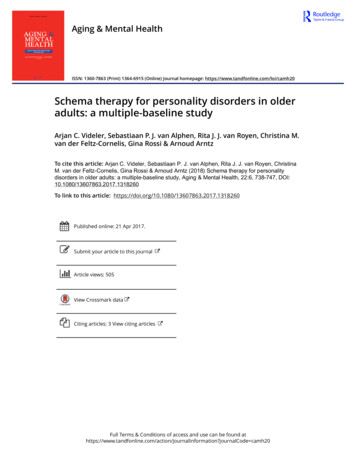
Transcription
Dijk et al. BMC Psychiatry(2019) Y PROTOCOLOpen AccessGroup schema-focused therapy enrichedwith psychomotor therapy versustreatment as usual for older adults withcluster B and/or C personality disorders: arandomized trialS. D. M. van Dijk1*, M. S. Veenstra1, R. Bouman1, J. Peekel7, D. H. Veenstra6, P. J. van Dalen5, A. D. I. van Asselt2,M. L. Boshuisen3, S. P. J. van Alphen4, R. H. S. van den Brink1 and R. C. Oude Voshaar1AbstractBackground: Several types of psychotherapy have been proven successful in the treatment of personality disordersin younger age groups, however studies among older patients are lacking. We developed a group schema-focusedtherapy (SFT) enriched with psychomotor therapy (PMT) for older adults with cluster B and/or C personalitydisorders. This paper describes the design of a randomized controlled trial (RCT). We will evaluate the (cost-)effectiveness of this therapy protocol in specialized mental health care. We hypothesize that our treatment programis cost-effective and superior to treatment as usual (TAU) in reducing psychological distress and improving qualityof life in older adults treated to specialized mental healthcare.Methods: A multicenter RCT with a one-year follow-up comparing group schema-focused therapy enriched withpsychomotor therapy (group SFT PMT) and TAU for adults aged 60 years and older who suffer from either acluster B and/or C personality disorder. The primary outcome is general psychological distress measured with the53-item Brief Symptom Inventory. Secondary outcomes are the Schema Mode Inventory (118-item version) and theYoung Schema Questionnaire. Cost-effectiveness analysis will be performed from a societal perspective with theEuroQol five dimensions questionnaire and structured cost-interviews.Discussion: This study will add to the knowledge of psychotherapy in later life. The study specifically contributes tothe evidence on (cost-) effectiveness of group SFT enriched with PMT adapted to the needs of for older adults withcluster b and/or c personality.Trial registration: Netherlands Trial Register NTR 6621. Registered on 20 August 2017.Keywords: Schema focused therapy, Psychomotor therapy, Older adults, Group therapy, Personality disorders,Multicenter RCT, Cognitive techniques, Experiential techniques, Design article* Correspondence: S.d.m.van.dijk@umcg.nl1Department of Psychiatry, University of Groningen, University MedicalCenter Groningen, Post office box 30.001, 9700, RB, Groningen, TheNetherlandsFull list of author information is available at the end of the article The Author(s). 2019 Open Access This article is distributed under the terms of the Creative Commons Attribution 4.0International License (http://creativecommons.org/licenses/by/4.0/), which permits unrestricted use, distribution, andreproduction in any medium, provided you give appropriate credit to the original author(s) and the source, provide a link tothe Creative Commons license, and indicate if changes were made. The Creative Commons Public Domain Dedication o/1.0/) applies to the data made available in this article, unless otherwise stated.
Dijk et al. BMC Psychiatry(2019) 19:26BackgroundThe prevalence rate of personality disorders amongcommunity-dwelling older people is estimated at 8% [1]and varies between 33 and 58% among older people referred to specialized mental health care [2–4]. The disease burden due to personality disorders is high forpatients (lowered quality of life, high levels of psychological distress and a high suicide risk) as well as for society (increased medical consumption and informal care)[5, 6]. For example, maladaptive personality traits are associated with a 16–30% increase in somatic healthcareconsumption among older adults [7, 8]. Adequate detection and treatment is therefore warranted from both apatient and societal perspective. Even in specializedmental health care for older adults, personality disordersoften remain undiagnosed and undertreated [9, 10].Among younger patients several psychological therapies,among which schema focused therapy (SFT) have beendeveloped that effectively reduce the burden of personality disorders [11, 12]. SFT addresses how early maladaptive schemas influence daily life and interpersonalrelationships. Schemas pertain to one’s core conceptionsof self, others and the world. They are formed in childhood and adolescence. In case of adverse circumstances,maladaptive schemas and associated coping styles will develop to survive (emotionally) which later on, in a healthier environment will lead to interpersonal dysfunctionalcoping and emotional instability. SFT helps patients toidentify their most important maladaptive schemas and torespond in a more adaptive manner when these maladaptive schemas are triggered in daily life.Review studies in adults ( 60 years) on the treatmentfor personality disorders concluded that SFT improvesquality of life for the borderline personality disorder.They found a recovery from psychological symptomsand that it was less expensive compared to usual care[12]. The aforementioned studies focused on the borderline personality disorder [11] for which SFT was originally developed [13]. However, effectiveness of SFT hasalso been proven for the avoidant personality disorder[14], mixed group personality disorders [15], and morerecently for the chronic mood- and anxiety disorders[16, 17]. Although SFT is generally delivered in an individual format, group SFT is considered to speed up andamplify the effects of individual SFT [18]. Even so-calledshort-term group SFT [19] is associated with improvements in affective symptoms as well as personality pathology. Studies in younger and middle aged patientswhich tested the association between the effect of SFTand age did not find a significant impact of age [18, 20].Extrapolation of these findings to older samples maysuggest that SFT also remains effective in later life. Of allpsychotherapies focused on personality disorders, SFT isconsidered most relevant for geriatric practice due to itsPage 2 of 14favorable effects on comorbid, often longstanding affectivedisorders [21–23]. To date, only three uncontrolled studies of SFT among older adults have been published [9].These studies point to favorable effects of SFT in later life.First, among 51 depressed inpatients, SFT led to improvement of depressive symptoms, anxiety and five out of theseven maladaptive schemas [24]. Second, among 31 Dutcholder outpatients, group SFT improved psychologicaldistress with effect-sizes similar to those reported foryounger patients. Moreover, changes in early maladaptiveschemas mediated change in psychological distress in thislatter study [21]. Third, in a multiple-baseline case seriesstudy among 8 older persons suffering from a cluster Cpersonality disorder, psychopathology remained stableduring an extended baseline period, while psychopathology significantly diminished during treatment andfollow-up [25].Although these studies among older patients arepromising, some caution is needed since no randomizedcontrolled studies evaluating SFT in later life have beenconducted yet [9]. Therefore, we decided to performsuch a randomized controlled trial and to present itsstudy design here. SFT protocols examined among olderpatients up to now highly relied on cognitive techniques.Since cognitive techniques may become less effectivewith increasing age [26], we added several experientialtechniques. These techniques are considered powerfulmethods to change early maladaptive schemas in olderadults [21]. Not only did we add experiential techniquesto the traditional, verbal SFT approach, we also enrichedour treatment protocol with PMT. By offering PMT, patients will experience how their schemas influence theirbehavior and feelings. The ‘learning by doing’ approachoffers opportunities to try out new behaviors [27]. Moreover, discovering the origin of feelings and physical sensations is an important therapeutic mechanism of SFT.PMT contributes to this important ingredient of SFT, byusing bodily awareness and physical activities to letpatients experience the way they tend to behave [28].During the preparation phase of this trial, we ran fivetreatment groups to refine our protocol and test itsfeasibility. Participants of these pilot groups highly appreciated the psychomotor therapy, the experientialtechniques and the adaptation of SFT to a geriatricpopulation, in general.Study objectivesThe aim of this article is to describe the design of a RCTexamining the (cost-)effectiveness of group SFT enrichedwith PMT compared to treatment as usual for older patients suffering from a cluster B and/or C personality disorder. We hypothesize that our treatment program iscost-effective and superior to treatment as usual (TAU) in
Dijk et al. BMC Psychiatry(2019) 19:26reducing psychological distress and improving quality of lifein older adults treated to specialized mental healthcare.MethodsDesignWe designed a multi-center randomized controlled trialwith two parallel treatment groups: 20 sessions of groupSFT enriched with PMT delivered over a 6-monthsperiod, versus treatment as usual (TAU) for older adultswith cluster B and/or C personality disorders in specialized mental health care. Primary outcome is generalpsychological distress. In addition, cost-effectiveness of theintervention from a societal perspective is evaluated.Outcome measurements will be administered pre- andpost-treatment as well as at 6 and 12 months posttreatment. Six mental health care organizations in theNorthern Netherlands agreed to participate, one universitydepartment of geriatric psychiatry (University MedicalCenter Groningen) and five affiliated mental health organizations (GGZ Friesland van Andel department, GGZDrenthe, Lentis, Dimence and Mediant). The study hasbeen approved by the Medical Ethics Committee of theUniversity Medical Center Groningen on May 12th, 2017(M17.212189) and was registered in the Dutch Trial Registeron August 20th, 2017 (NTR 6621).Study populationEligible are patients, 60 years or older with a cluster Band/or C personality disorder according to the DSM-5who are referred to or are currently treated at an outpatient clinic for geriatric psychiatry of the participatingcentres in the Netherlands. According to DSM-criteria,the criterion threshold for diagnosing a personalitydisorder in older patients is too strict [29, 30]. For thatreason we will also include older patients falling shortone content criterion for a specific cluster B and/or Cpersonality disorder, provided that they meet the generaldiagnostic criteria for a personality disorder (hereafter‘subthreshold cluster B/C personality disorder’). Olderpatients generally endorse fewer specific personalitydisorder criteria than younger age groups (29% of thecriteria contain measurement bias in older age groups),while the latent variable structure for each personalitydisorder suggests a similar severity level of personalitypathology [30]. Specific inclusion criteria are: 1) age of60 years or above; 2) cluster B or C personality disorder(or falling one content criterion short) as confirmed bythe Structured Clinical Interview for DSM-5 for personality disorders (SCID-5-PD) [31] 3) mentally able toadhere to the group SFT treatment schedule and to fillout the schema (mode) questionnaires and 4) givinginformed consent after having received oral and writteninformation. Exclusion criteria are: 1) severe currentmental illness, including bipolar I disorder, psychosis, orPage 3 of 14substance abuse disorders needing clinical detoxification; 2)an established neurodegenerative disorder; 3) cognitive impairment defined as a sum score below 23 points on theMontreal Cognitive Assessment (MoCA) battery [32]; 4)having received schema-focused therapy in the previousyear or during the current illness episode; and 5) suiciderisk interfering with adequate treatment delivery. Physicalrestraints or physical frailty are no exclusion criterion.Despite the group format, the PMT will be individuallyadapted so that even the frailest patients can participate.RecruitmentMental health professionals working at the different sitescan inform patients about the study when a cluster B or Cpersonality disorder is suspected. After having receivedoral and written study information from their mentalhealth professional interested potential eligible patientswill get an appointment with the clinical psychologist attheir clinic. During this screening session, the in- and exclusion criteria for the study are formally checked by administering amongst others the SCID-5-PD and MoCAand any remaining questions the patient has about thestudy are answered. For patients not meeting the in- andexclusion criteria the study ends after this screening session. Patients eligible for the study, will be given another 2weeks to consider participation. Patients willing to participate in the study, will be asked to sign informed consentand are put on a waiting-list. Only the patients who gavewritten informed consent are included in the study. Thedata from the screening appointment, will be passed on –anonymously – for inclusion in the study database. Whena minimum of 8 and maximum of 16 patients have giveninformed consent at a specific site, baseline measurementswill be conducted, after which participants will be randomized (see flowchart) Fig. 1.Sample size calculationThe only RCT comparing group SFT with TAU was conducted among younger adults with borderline personality disorder and found a between group Cohen’s d effectsize (ES) of 2.0 on the Brief Symptom Inventory (BSI-53)[33]. For our power analysis, we tuned down the expected ES to 0.5 (medium effect) for two reasons. First,the ES of 2.0 was partly due to absence of an effect ofTAU [34] while meta-analysis of psychotherapy in geriatric psychiatry shows an average pre-post ES of 0.4 forTAU [17]. Second, an open study on group SFT reporteda pre-post Cohen’s d ES of 0.8 among older adults withmixed cluster B and C personality disorders [21]. Applying a 2-sided alpha of 0.05 and a power of 80% to detectan ES of 0.5, requires 63 patients per arm. Althoughcompensation for dropout is not necessary according tothe CONSORT criteria when performing intention totreat analyses (http://www.consort-statement.org/), we
Dijk et al. BMC Psychiatry(2019) 19:26Page 4 of 14Fig. 1 depicts the flowchart of the studyaim to include 140 patients in order to compensate for10% early dropouts during the waiting-list period. Differences in the scores between the intervention and controlgroup on the various outcome measures (BSI-53,EQ-5D-5 L, YSQ and SMI) will be analyzed using linearmixed-models accounting for missing data and relevantconfounders.Randomisation, blinding and treatment allocationA stratified block randomisation will be performedaimed to assign participants evenly (1,1) over the twoconditions [35]. Randomisation will be performed perstudy site and stratified by the presence of a full versussubthreshold cluster B/C personality disorder (PD – 1criterion). Participants will be randomized in blockswhen 8 to 16 consecutive patients have consented toparticipate at a specific study site. Randomisation will beperformed centrally using online randomisation softwareQuickCalcs of GraphPad (http://www.graphapd.com/quickcalcs/randMenu).) by an independent investigatorwho will be blind to patient characteristics. Patients willbe randomized in even patient numbers per stratum. Incase of an uneven number of participants per stratum,the next even number of patients will be randomisedand the last allocation will be forwarded to the nextblock randomisation with an uneven number of patientswithin that stratum. After randomisation, patients andtheir responsible geriatric psychiatrist or psychologistwill be informed of their allocation. The therapistsdelivering the intervention will be informed which patientscan be invited for group SFT PMT.Group Schema-focused therapy enriched with PMTTwo individual pre-treatment sessions without PMTtake place before the group sessions. These are meant tomake a personal treatment plan based on administeringthe Young Schema Questionnaire (YSQ) and SchemaMode Inventory (SMI) (see Mediators section below)
Dijk et al. BMC Psychiatry(2019) 19:26and to explain the concept of group SFT enriched withPMT in more detail. The subsequent group interventions comprise 20 sessions over a period of 26 weeks.The first 18 sessions will be provided weekly after whichtwo follow-up sessions are given at week 22 and 26.Each treatment session consists of a 2 h group sessionSFT and 1 h group session PMT, with a 15-min break inbetween. Treatment is provided according to a detailedprotocol. This protocol is highly structured and basedon the Dutch protocols short cognitive schema-focusedgroup therapy [36] and experiential techniques [37, 38].During the initial group sessions, patients will be furthereducated about the schema model, specifically in relation to their own three predominant schemas and coping styles (called ‘modes’ in schema focused therapy). Inthe second treatment phase the patients maladaptiveschemas will be triggered and patients will be taught torespond in a more adaptive manner. In this treatmentphase the ‘experiential imagery rescripting’ and ‘chairinterventions’ will be conducted [37, 38]. All patients receive a personal schema-focussed therapy workbook forolder adults. This workbook will be extended every session with a summary of the session information andhomework assignments. The patients will write a weeklysummary of their therapy process and fill in a ‘severityscore form’. On this form patients rate the severity oftheir 3 predominant schemas and maladaptive modes.Based on clinical experience with older persons, geriatricthemes like loss of a role in society, loss of loved-ones,comorbid somatic diseases and sociocultural beliefs inthe treatment of elderly, are integrated in the treatmentprotocol [39, 40]. Furthermore, the protocol has beenenriched with PMT to overcome the limitations of verbal therapy. During PMT, the psychomotor therapist setsup individual and group-based physical interventions tofacilitate that patients experience their schemas andmodes. Continuity between the verbal and psychomotorsessions is guaranteed by participation of the psychologist in the PMT as co-therapist. This way the observations pending PMT can be further analyzed in theverbal sessions.Treatment as usualTreatment as usual (TAU) will be unrestricted as long asno group SFT is provided. Usually this means that amultidisciplinary team will determine the best treatmentfor each patient. This can be either psychotherapeutic ordrug treatment, individual or group treatment, outpatient-, day- or inpatient treatment or any combinationdeemed necessary. The treatment provided will be registered, to facilitate interpretation of results. From ourclinical experience, we expect that TAU will mainlyconsist of structured and supportive case-managementof personality problems or treatment restricted toPage 5 of 14(comorbid) axis I psychiatric disorders, ideally accordingto disorder specific guidelines.Therapists, training and supervisionAll interventions in the experimental group are providedby psychologists with a minimum of 2 years postgraduate clinical training in combination with fully licensed and registered psychomotor therapists. Duringthe verbal SFT sessions, a co-therapist will participate.Co-therapists are generally also psychologists but psychotherapeutic oriented nurse practitioners experiencedin group treatment are also allowed. One of the psychologistsproviding verbal SFT will also participate as co-therapist inthe PMT sessions. All psychologists and psychomotortherapists receive a two-day training led by the first author, aclinical psychologist who is also a licensed schema-focusedtherapist. The psychomotor therapists are trained by the thirdauthor. This training covers how to deliver a structured SFTprogram, training of the SFT adaptations to older adults andPMT techniques. The training is supported by video materialof verbal SFT and PMT techniques. All therapists receive amanual with the treatment protocol, including a detaileddescription of all sessions divided in a SFT and aPMT section. Moreover, to improve protocol compliance, the SFT-interventions provided must be tickedoff on standardized forms (part of the manual) persession. Session attendance of the individual patientswill also be recorded by the therapists. During thestudy, all therapists will participate in a monthlysupervision program provided by the first and thirdauthor. Furthermore, all SFT and PMT group sessionsin the intervention arm will be audiotaped and savedfor evaluation. Of each therapy group two audiotapeswill be randomly selected and rated by independentpsychologists on protocol compliance. All interventions listed in the treatment manual for the selectedsession will be evaluated on whether or not the intervention was delivered and the quality of that deliverance,as rated on a scale ranging from 0 (not delivered) to10 (delivered excellently). A total of at least 10 tapeswill be rated by two raters to assess the interrater reliability, as expressed the intra class correlation coefficient(ICC) [41].AssessmentsData are collected at the following moments: at thescreening, baseline (T1), at the end-of-treatment (T2, i.e.6 months after baseline for the TAU group), and finallyat 6- and 12-month follow-up (T3 and T4). Many outcomes consist of self-report measures. Some are assessedby structured telephone interviews conducted by research assistants who will be blind about the treatmentallocation of the interviewed patient. These interviewsinclude assessment of socio-demographic characteristics
Dijk et al. BMC Psychiatry(2019) 19:26Page 6 of 14and psychiatric history (at baseline only) as well asmedical consumption and costs in the past 3 months.Personal information about potential and enrolled participants will be stored confidentially. Table 1 shows thequestionnaires used at each assessment.BSI-53 subscales is rated as good and their convergentand divergent validity has been found to be satisfactory[42], subscale scores will be examined as secondary outcome parameters.Economic evaluationPrimary outcome parameterPsychological distress in the past week, as indicated bythe sum score of the Brief Symptom Inventory 53 itemversion (BSI-53), is the primary clinical outcome parameter. The BSI-53 is a self-report questionnaire and an abbreviated version of the Symptom Checklist-90 (SCL-90)[33, 42]. The BSI is validated for older adults and preferred over the SCL-90 since validation studies in olderadults did not indicate any information loss compared tothe SCL-90 [43]. We have chosen for psychologicaldistress as the primary outcome parameter since 1) olderpatients with personality problems are rarely referred togeriatric mental healthcare for personality problems specifically, but nearly always for associated affective symptoms and 2) the study includes patients with a variety ofpersonality disorders. Since the reliability of the DutchThe EuroQol-5D-5 L (EQ-5D-5 L), a generic self-reportinstrument, will be administered to measure health-related quality of life at the time of assessment [44]. Itconsists of five questions, each related to a specific dimension of health status: mobility, self-care, usual activity, pain/discomfort and anxiety/depression. The utilityscore of the EQ-5D-5 L will be used to calculateQuality-Adjusted Life-Years (QALYs) [45]. Medical consumption and other cost data will be collected by meansof structured telephone interviews, as previously done ina younger patient group [44]. Since a considerableamount of resource use is situated outside (mental)healthcare institutions, data of formal registries such ashospital information systems or insurer’s databases areincomplete [44]. Therefore, patient-reported prospectivecost diaries [46] or retrospective cost interviews [47], areTable 1 .shows the questionnaires used at each assessmentTime of assessmentScreeningBaselinePost treatment assessment6-month Follow-up12-monthFollow- upPrimary outcomesPsychological distress: BSI-53XXXXHealth-related quality of life: EQ-5D-5 LXXXXMedical consumption & costsXXXXLife satisfaction: Cantril’s LadderXXXXMental wellbeing: WEMWBSXXXXPersonality functioning: SIPP-SFXXXXInteroceptive body awareness: MAIAXXXXXXXXSecondary outcomesPsychotropic drug use & treatment receivedMood variability: Mood-ZoomCharacteristicsPersonality disorders: SCID-5-PD Cluster B & CXMental disorders: MINI-PlusXCognitive screening: MoCAXPsychiatric treatment history: telephone interviewXSocio-demographics: telephone interviewXChronic illnesses: LASA questionnaireXEarly life-events: NEMESIS questionnaireXAlcohol use: AUDITXCurrent smoking: NEMESIS questionsXPhysical activity: NEMESIS questionXPersonality traits: PID-5-SFX
Dijk et al. BMC Psychiatry(2019) 19:26the preferred instruments covering all relevant events.We have chosen a 3-month recall interview [48, 49]since a prospective cost diary or a recall interview over alonger period are expected to lead to more missingitems.Secondary outcome parametersA number of secondary outcome parameters have beenchosen to specify the extent and nature of the effect ofgroup schema focused therapy in later life.Psychotropic drug useData on current psychotropic drug use and changes inbetween assessments will be collected as part of the telephone interviews, described above.Life satisfactionLife satisfaction will be assessed with Cantril’s ladder, asingle self-report question to rate one’s current life situation on a scale (from 0 to 10) [50]. Life satisfaction is aconceptualization of subjective wellbeing which stressesthe cognitive evaluation of one’s life situation, in contrastto for example feelings such as happiness. A score of 0indicates ‘the worst possible life for you’ and 10 ‘the bestpossible life for you’.Page 7 of 14tool to assess effects of therapy on levels of personalityfunctioning in this age group [54].Interoceptive body awarenessInteroceptive body awareness is assessed with the Multidimensional Assessment of Interoceptive Awareness(MAIA) [55]. The MAIA is a 32-item self-report questionnaire, measuring eight dimensions covering both theability to notice bodily sensations and to regulate theirinfluence on behavior. Treatment responsiveness of theMAIA was recently shown in a study on bodily focusedcontemplative training [56] which found improvementson five of the eight MAIA scales.Mood variabilityTrying to measure emotion dysregulation in real life situations, we will assess mood variability with theself-report Mood Zoom, an experience sampling methodfor real-time mood assessment on a smartphone [57].Participants are prompted by the phone to rate theircurrent mood on a screen displaying six different moodswhich have to be scored on 7-point Likert scales. Wewill prompt participants three times a day, at randomtime points, over a one-week period per assessment.Mental wellbeingPatient characteristics (and potential predictors oftreatment outcome)Mental wellbeing is assessed with the Warwick-EdinburghMental Well-being Scale (WEMWBS) [51]. Mental healthand mental illness have been shown to be related butdistinct concepts [52]. Reduction or absence of mental illness does not necessarily imply good mentalhealth and wellbeing. The WEMWBS focusses on mentalwellbeing and consists of 14 items covering positive affect,satisfying interpersonal relationships and positive functioning. Items have to be rated on a 5-point Likertscales assessing the frequency of the positive feelingover the past 2 weeks. A higher sum score indicates abetter mental wellbeing.Patient characteristics will be assessed during the screening procedure in order to verify in- and exclusion criteriaand the formal baseline assessment, to describe the studysample, and to test and control for baseline differences between the study groups. The screening procedure includesthe formal assessment of cluster B or C personality disorders, 2) comorbid mental disorders, and 3) cognitive functioning. The formal baseline assessment includes 4) apsychiatric treatment history, 5) socio-demographics, 6)chronic somatic diseases, 7) early life events, 8) alcoholuse, 9) current smoking, 10) physical activity and 11) personality traits.Personality functioningPersonality disordersPersonality functioning is assessed with the Severity Indices of Personality Problems – Short Form (SIPP-SF)[53]. The SIPP-SF assesses five core domains of (mal)adaptive personality functioning defined in the DSM-5alternative dimensional personality disorders model,namely: Identity Integration, Self-Control, RelationalFunctioning, Social Concordance and Responsibility.The 60-items of the questionnaire consists of propositions referring to the last three-months, which are answered on four-point Likert scales, ranging from fullyagree to fully disagree. Higher scores imply more adaptive functioning. The SIPP-SF has been studied in anolder sample and was suggested to be a useful clinicalPersonality disorders, according to the traditional categorical DSM-5 model, will be assessed with the Structured Clinical Interview for DSM-5 for personalitydisorders [31]. To minimize patient burden, the interview will be limited to the general diagnostic criteria fora personality disorder and the cluster B or C personalitydisorder criteria.Mental disordersComorbid psychiatric disorders will be assessed with theaid of a DSM-5 checklist. This checklist summarizes allDSM-5 criteria for the following disorders: Major Depressive Disorder, Persistent Depressive Disorder, Manic
Dijk et al. BMC Psychiatry(2019) 19:26and Hypomanic Episodes, Bipolar Disorders type I and II,Generalized Anxiety Disorder, Panic Disorder, Agoraphobia, S
Background: Several types of psychotherapy have been proven successful in the treatment of personality disorders in younger age groups, however studies among older patients are lacking. We developed a group schema-focused therapy (SFT) enriched with psychomotor therapy (PMT) for older adults with cluster B and/or C personality disorders.
